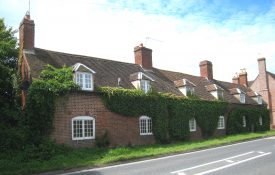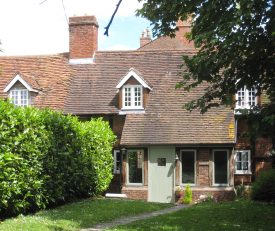This almshouse was founded in 1518 by Sir Robert Throgmorton of nearby Coughton Court. It stands modestly on the Birmingham Road close to the entrance to Coughton Court.
The inhabitants
The original foundation was for five men who were poor or needy, especially previous tenants or servants of the Coughton estate. The men were given 7d a week, which by 1830 has risen to £4 a year. Later on, accommodation was provided for six men.1 However by 1891 six women were living there.2 In 1901 there was one man living there: widower George Clark (who’d been born in Coughton and worked there as an agricultural labourer) plus four widows, including two who’d been in the almshouse at least ten years and Mary S. Bird.3 By 1911 there were five widows living there including Martha Ann Trout. 4 (I do hope the 1921 census will reveal yet another person with a creature’s name!)
The building
The original almshouse became unfit for habitation and was rebuilt in the early 19th century by another Sir Robert Throckmorton. The front of the ‘new’ almshouse is made of brick with a low tiled roof and – surprisingly – no doors. The back reveals some timber framing (which may be ancient). The building was still in use as an almshouse in 1911. However, it has since ceased to be an almshouse, with the six units converted into three cottages.
What’s in a name?
The almshouse used to be known – rather charmingly – as the ‘Port of Rest’ almshouse. Later on it was known as Coughton Cross Cottages, and now as Cross Cottages; it is Grade II listed and appears on Historic England’s Images of England (entry no. 1355404).
References
1 Charity Commissioners Reports for Warwickshire 1815-35, p. 23.
2 1891 census RG12/2481/f.101/p.9.
3 1901 census RG13/2944/f.50/p.11.
4 1911 census RD395/03/18833.









Comments
Add a comment about this page